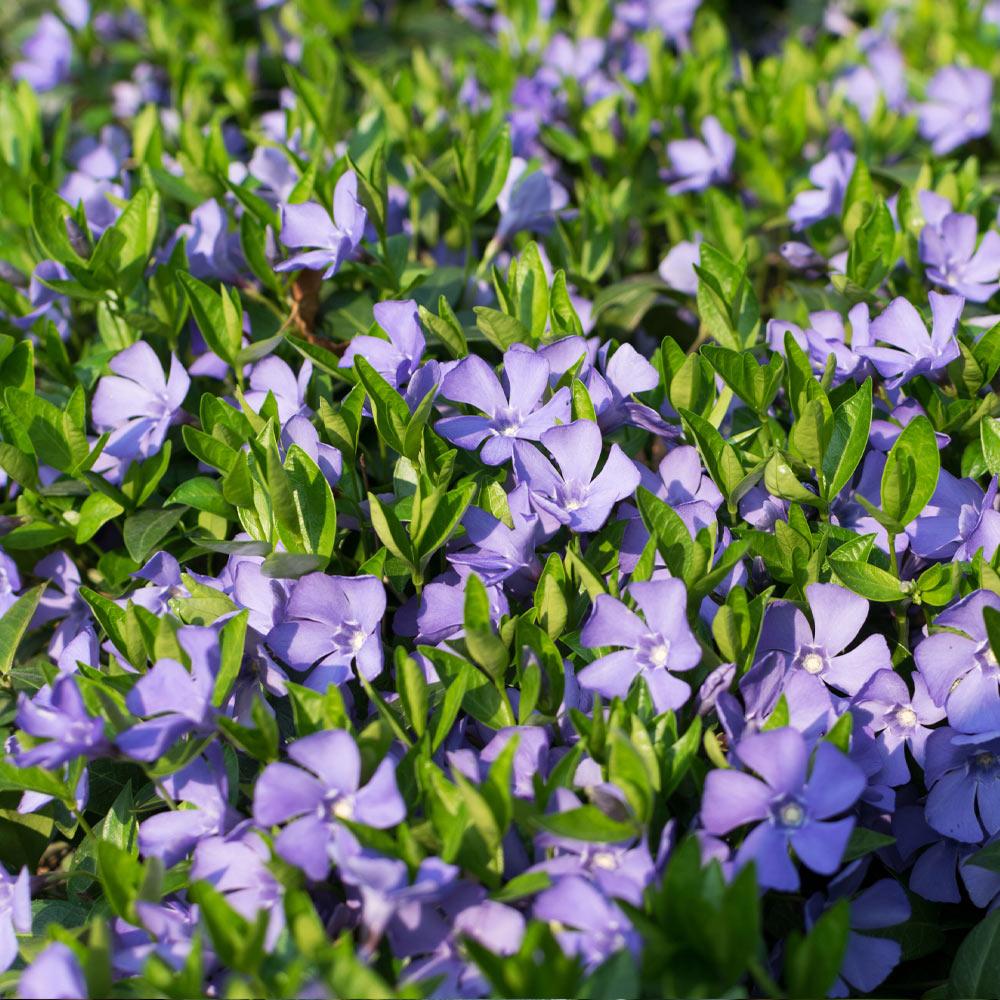While some garden plants command attention with their height or flamboyant blooms, Periwinkle charms with quiet persistence. It carpets the ground in lush green foliage, accented by small but radiant blue, purple, or white flowers. Often used to control erosion or bring life to shady corners, this unassuming beauty spreads gracefully and effortlessly.
More than just filler, periwinkle embodies resilience and balance—a plant that thrives where others fail, asking little in return but giving your garden structure, texture, and a subtle touch of color.

Portrait of the Periwinkle
Periwinkle, also known as Vinca, is a low-growing evergreen groundcover from the Apocynaceae family. The two main species are Vinca minor (lesser periwinkle) and Vinca major (greater periwinkle), both valued for their glossy leaves and trailing habit.
- Type: Evergreen groundcover
- Family: Apocynaceae
- Common Names: Periwinkle, Vinca, creeping myrtle, trailing myrtle
Foliage and Form
With its trailing stems and shiny, oval-shaped leaves, periwinkle forms dense mats that crowd out weeds. It’s often used beneath trees, on slopes, or in woodland gardens.
- Height: 10–20 cm (4–8 in)
- Spread: Up to 1.5 m (5 ft) or more
- Growth Habit: Spreading, trailing, mat-forming
Blooms and Fragrance
Though its flowers are small, they appear in abundance, especially in spring, creating a soft wave of color above the leaves.
- Bloom Time: April to June, with occasional blooms in summer/fall
- Color: Blue, lavender, violet, white
- Fragrance: Mild to none
The Right Time to Plant, Prune, and Enjoy Periwinkle
| Month | Planting | Flowering | Pruning |
|---|---|---|---|
| January | ❌ | ❌ | ✅ Tidy up dead stems |
| February | ✅ Start indoors or prep ground | ❌ | ✅ Light cleanup |
| March | ✅ Best planting time | ❌ | ✅ Trim for shape if needed |
| April | ✅ Plant out | ✅ Bloom begins | ❌ |
| May | ✅ | ✅ Peak bloom | ❌ |
| June | ❌ | ✅ (last blooms) | ✅ Light trimming after bloom |
| July | ❌ | ❌ | ✅ Cut back overly long runners |
| August | ✅ (cooler climates) | ❌ | ✅ Shape and thin as needed |
| September | ✅ Good time for propagation | ❌ | ✅ Refresh older patches |
| October | ✅ Fall planting | ❌ | ✅ Remove debris |
| November | ✅ (mild regions) | ❌ | ✅ Prune lightly before winter |
| December | ❌ | ❌ | ✅ Tidy up frost-damaged stems |
✅ = Recommended ❌ = Not advised
Watering, Sunlight, and Environment for Periwinkle
Watering
Periwinkle is low-maintenance, especially after establishment. It prefers moist soil initially but becomes drought-tolerant.
- When to Water: During establishment; dry spells
- How Much: Moderate; avoid soggy soil
- Watch out for: Root rot in poorly drained areas
Sunlight
It adapts to a range of light conditions—from full sun to deep shade—though flowering is more robust with some sunlight.
- Ideal Exposure: Partial shade
- Too Much Sun: May scorch in hot climates
- Deep Shade: Less flowering, more leaf growth
Indoor vs Outdoor
Though compact, periwinkle is meant for outdoor groundcover use. Indoors, it lacks the space and airflow to thrive.
- Best Location: Slopes, borders, under trees, shady beds
- Avoid: Growing in containers indoors long term
Temperature
Hardy and adaptable, periwinkle tolerates a wide range of climates. In cold zones, it may go semi-dormant in winter.
- Optimal Range: 10–25°C (50–77°F)
- Hardiness Zones: USDA zones 4–9
- Protection Tip: Mulch in colder zones for winter protection
Ideal Soil Conditions for Growing Periwinkle
| Soil Feature | Optimal Condition | Why It Matters |
|---|---|---|
| Soil Type | Loamy, clay-loam | Retains moisture but drains well |
| Texture | Loose to medium | Supports spread and root formation |
| Drainage | Good drainage essential | Prevents fungal issues |
| Moisture | Evenly moist during growth | Encourages quick establishment |
| Soil pH | Slightly acidic to neutral (6.0–7.0) | Promotes healthy foliage and flowering |
| Fertility | Low to moderate | Thrives in average soil |
Common Problems & Solutions
| Issue 🐾 | Symptoms 🔍 | Solutions 🛠️ |
|---|---|---|
| Overgrowth 🌿 | Spreads aggressively | Contain with edging or regular trimming |
| Root Rot 💧 | Yellow leaves, wilting | Improve drainage, avoid overwatering |
| Powdery Mildew 🌫️ | White film on leaves | Increase airflow, treat with fungicide |
| Leaf Spot 🍂 | Brown or black lesions | Remove affected leaves, reduce moisture |
| Aphids 🐜 | Sticky residue, distorted tips | Spray with insecticidal soap or neem oil |
With minimal upkeep and maximum coverage, periwinkle is the perfect answer for tricky spots in your landscape. Whether it’s softening the base of a tree or stabilizing a slope, this plant quietly works behind the scenes—filling, flowering, and flourishing where others fade.